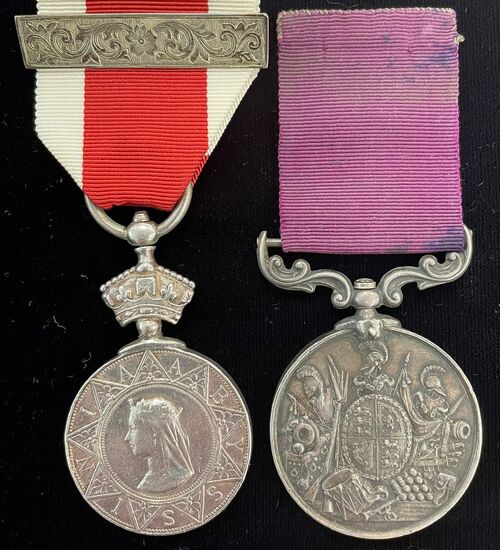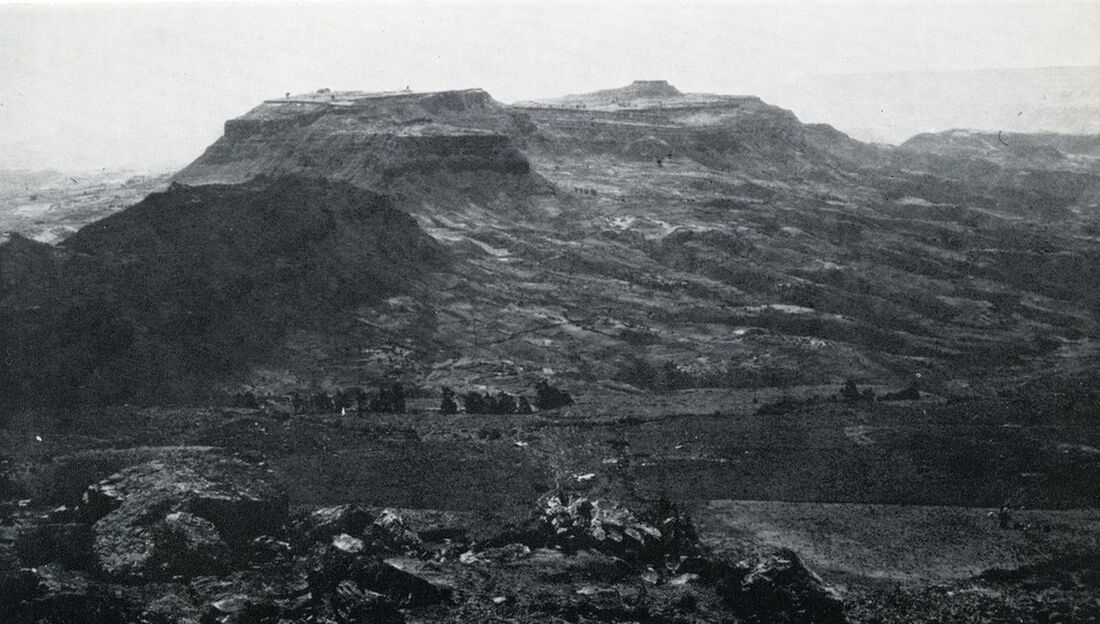Auction: 23002 - Orders, Decorations and Medals
Lot: 38
'Mute is our dear comrade in death, his cares and his battles and strife have come to an end in this world suddenly closed with his life.
Departed from everything dear - wife, children and comrades as well; but we trust in the goodness of God with the just he will evermore dwell.
The good and the just, we are told, sleep calm, like a babe at the breast, until the great trumpet shall call the quick and the dead from their rest.
Oh may we all meet there that day, our comrades, in brotherly love, with our Redeemer's kind welcome, to inhabit the Kingdom above.'
A poem read by Sergeant-Major James Pilgrims, 33rd Foot, at the burial of Colour-Sergeant C. Kifford D.C.M., the recipient of one of just seven D.C.M.'s for the campaign
The campaign pair awarded to Sergeant C. Kifford, 33rd Foot, who won a scarce D.C.M. for the storming of Magdala during the Abyssinia campaign
Abyssinia 1866-68 (275 Corpl. C. Kifford 33rd D. W. Regt); Army L.S. & G.C., V.R. (275. Sergt C. Kifford. 33rd Foot) the first with re-soldered suspension and contact marks, the second toned contact marks very fine (2)
[D.C.M.] London Gazette 1868:
'For services at the Assault on Magdala, Abyssinia.'
Charles Kifford was born near Watford, Hertfordshire in July 1839. An agricultural labourer by trade, he enlisted in the 33rd Foot (Duke of Wellington's Regiment) at St. Albans on 15 February 1858.
Theodore's Abyssinia
Abyssinia at this time was ruled by the self-made king Theodore. A Christian fanatic claiming descent from Solomon, he sought British military assistance for his self-styled crusade against Islam. The British, though nominally supportive of Christian evangelism, had no desire after the Indian Mutiny to be perceived as anti-Muslim. The multi-faith British Empire could only be maintained through religious tolerance; the British Government chose to ignore Theodore's request. Since he had written personally to Queen Victoria, Theodore felt deeply offended and incarcerated two British envoys and several missionaries in his hill-fortress of Magdala. In total, Theodore imprisoned 59 British and European hostages between 1864 and 1868.
Lord Stanley, the British Foreign Secretary, had made several diplomatic attempts to secure the prisoners' release. In April 1867 he offered Theodore British arms and machinery in exchange for the hand-over of prisoners at Massawa, a British outpost on the Red Sea. British public opinion, swayed by lurid storied in the press of Theodore's cruelty to prisoners, forced the Government's hand. Stanley had given Theodore three months to respond to his offer, but when this deadline passed military action seemed the only honourable course.
With Suez Canal still under construction, the military expedition would sailed from India with the 33rd Foot formed part of the 12,000-strong force assembled by Lieutenant-General Sir Robert Napier at Bombay. The force comprised four regular British battalions - from the 4th, 26th, 33rd and 45th Foot - and 10 native infantry regiments, mostly from the Bombay Presidency. Napier's force contained a brigade of native cavalry and a considerable artillery arm, including a battery of 9-pounders, two mountain batteries, two 8-inch mortars and a rocket troop formed from the Naval Brigade. The logistical matter of supply, which had caused Britain such embarrassment during the Crimean War, was given every consideration: Napier assembled 25,000 pack animals, railway tracks, water pipes, and vast quantities of tinned food.
Napier's army embarked on 150 transport ships and gradually landed at Annesley Bay on the Red Sea, the 33rd arriving in early December. The 33rd were greeted by a scene strongly reminiscent of the Kalamata Bay disembarkation in the Crimean War. The 25,000 pack animals were already landed, but no thought had been given to their sustenance and they were running around the beach uncontrollably.
Magdala lay 381 miles to the south.
The Advance on Magdala - D.C.M.
Throughout the winter, the 33rd were engaged in constructing roads to facilitate the advance - a tiresome and thankless task. No wonder then at Dildi in late March that a number of the Privates refused to march up a sheer cliff - Kifford may well have assisted in restoring the order.
It would be 4th Foot who were the first to engage Theodore's army at Arogi, just outside Magdala, on 10 April, as a result of the poor display at Dildi. Theodore, watching the British advance from his fortress, saw an opportunity to annihilate the enemy's vanguard and baggage train. Instead, his largely spear-armed warriors charged against the troops - now armed with 'Snider' breech-loading rifles capable of firing eight rounds a minute - and suffered 2,000 casualties. Theodore's remaining warriors fled into the countryside, leaving him with a small band of loyal retainers. When the bulk of Napier's army arrived with its 8-inch mortars, Magdala's capitulation seemed inevitable.
Theodore now opened negotiations, with Napier demanding the king's immediate surrender and release of prisoners. Theodore agreed to the latter: he gave the prisoners mules and sent them towards Napier's camp, where they were received with great rejoicing. Theodore would not, however, surrender his own person to the enemy. He held out until Napier launched a final assault on the fortress on 13 April. This assault was led by the 33rd Foot, the Naval Rocket Troop in support.
The 33rd advanced up the Islamgi plateau towards a rocky outcrop, 300 feet high, above which lay the fortress of Magdala. Sending ahead four companies in skirmish order to give covering fire, the remaining six companies under Major Cooper began picking their way up the narrow cliff path towards Magdala's main gate. When the gate was reached, it was discovered that the sappers detailed to blow it had forgotten their bags of powder. The 33rd were under fire and suffering casualties, but quick-thinking Major Simmons ordered three companies to swing right and attempt to scale the walls. Hacking through a defensive abatis of thorn bushes, a small party of the 33rd managed to mount the wall and open the gate from the inside. They were led by Private Bergin and Drummer Manger, who both received V.C.s for this action. As the 33rd streamed through the gate they encountered a corpse with a bullet-hole to the head. Next to the body was an ornate pistol bestowed as a gift by Queen Victoria in 1864, inscribed 'Theodorus, Emperor of Abyssinia'. The 33rd had found Theodore: he had chosen suicide instead of capture. The Abyssinian campaign was over.
Kifford was awarded the D.C.M.
Journey's end
Having been promoted upon his return home, Kifford transferred to the 6th West Yorkshire Militia with the rank of Colour-Sergeant. An able sprinter, he competed in the Militia games and won the 100m. race in both 1877 and 1878. Discharged in February 1879, and having had never been entered the defaulters' book, Kifford was also in receipt of the L.S. & G.C. Medal. Residing at Halifax he died on 13 March 1886 and was buried at Pellon Church with full military honours; sold with copied research.
Subject to 20% VAT on Buyer’s Premium. For more information please view Terms and Conditions for Buyers.
Sold for
£2,000
Starting price
£2000







